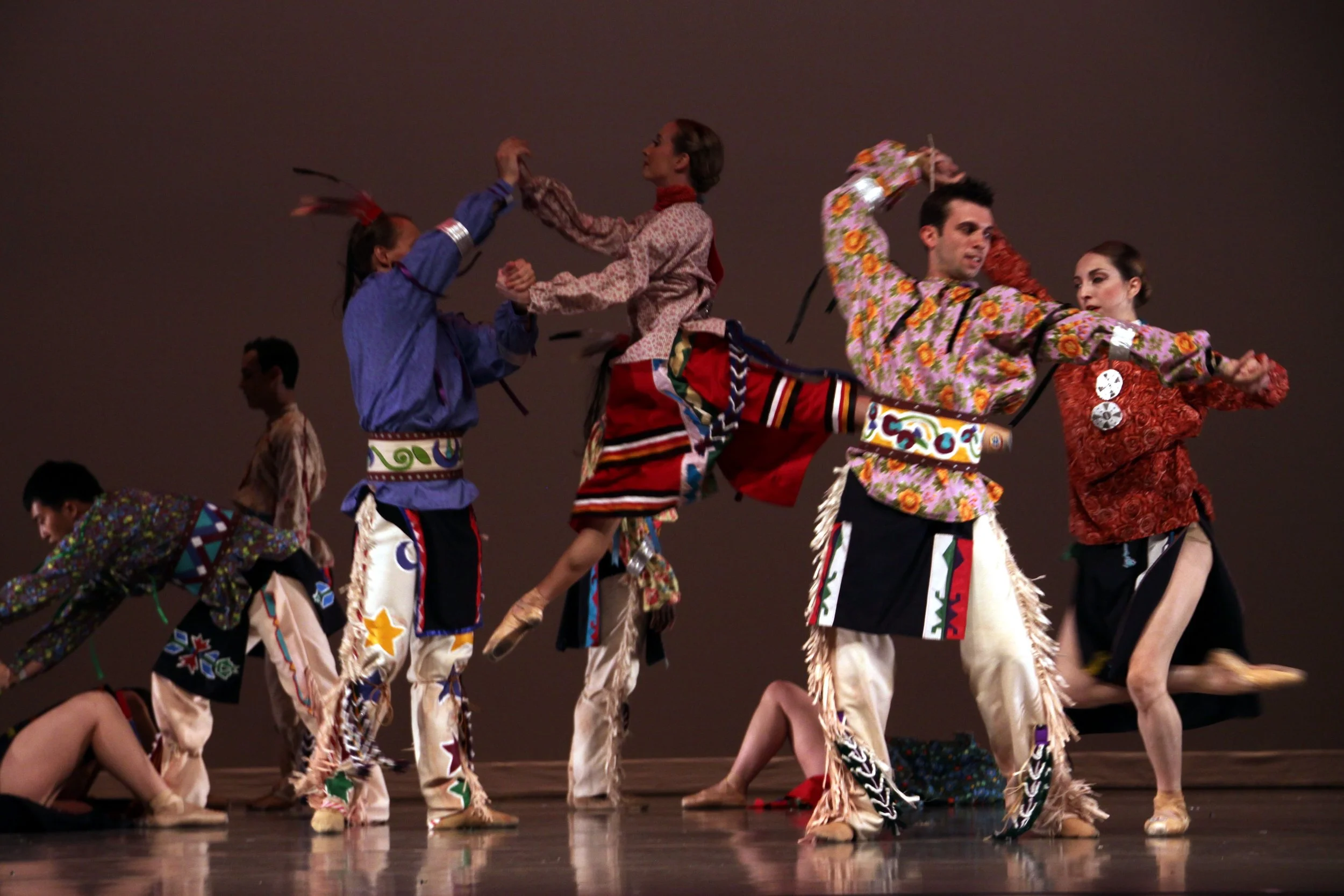Act One
Morning Prayer
Osages are a People who have enormous respect for all of life and the life giver. We begin our day with the rising sun and we pray. As we look up and see the stars and heavens, look out to see the plains stretching before us, and at dawn see the sun rise, vast and powerful over our children and our homes, we realize that amidst all of this we are but little ones. For centuries Osage men would take time for ceremony and prayer before they went on hunts. Before a woman put one seed in the ground, she would sing a prayer over it. While she scraped buffalo hides and made clothes, she would sing prayers over them. Children are still named in ceremonies involving prayer.
So to Wakontah, the creator of all things, we show humility. We pray for a peaceful day and for our families to be healthy, happy, secure, and safe. Everything we receive is a precious gift to be thankful for, so we pray.
Royalty of the plains
In early journals of missionaries to the area, Osages were often described as being “The Happiest people in the world”. They were happy whether they had a lot or a little and known to be very hospitable and welcoming. Their children were Wakontah’s sacred gift to them, and gave them certainty that they would go on as a People. They went on buffalo hunts in the spring and fall. Buffalo, were believed to be Wakontah’s gift of sustenance to the Osage People, and were a source of building materials, bedding, tools, weapons and utensils. Osages found a use for almost all of the buffalo and only killed what they needed. They also hunted deer, elk and turkey, and planted pumpkins, squash, corn and beans. In the summers, they would move to a higher elevation to get away from mosquitoes, and in the winter moved deeper into the woods for protection from the elements where wood was readily available for heat. They could pack up their longhouses and belongings, and move whole villages 30 miles in a day. Pre-contact Osages were self-governed, content, in harmony with nature and the cosmos, and aware of the Creator; there was unity with the people which gave them strength.
Pre-contact “wedding”
In the early days of the Osage, a couple was brought together by arrangement. They were always from different Clans which accounted for their tall stature (6 to 7 feet tall) and the beauty of the Osage as a people. Since adolescent boys and girls were not allowed to speak to or socialize with each other it was the responsibility of the boy’s parents to find him a suitable wife. There was a men’s council and a women’s council that would go back and forth until a deal was struck. The elder council would tell the boy and girl about life together and what to expect. At the feast, they would sit next to each other and there would be water to symbolize everlasting life (where the rivers meet). If either party did not partake in the wedding meal, the arrangement would be called off. When they came together, the man would move in with the girl’s family and become the provider for that family.
Treaties
The first recorded contact of Europeans and the Osage was through the Spanish explorers in 1541. French explorers arrived in the 1600’s. The Osages were exceptional business people and set up villages in the vicinity of trading posts where they could trade furs. It is said that they monopolized the Santa Fe Trail for 100 years. In 1723 Etienne Venyard Bourgmont won the right to construct Fort Orleans on the Missouri River and the Osage dealings with the French gave them exclusive rights to fur trading in the area, making them wealthy even by the standards of the day. But the Osage Nation was in the way of the economic drive of the European world to accumulate land, metal and fur. Treaties were made as the Osages were pushed further and further west into smaller areas of land.
The notice (move from Kansas)
Through the 18th and 19th centuries, Indians on the American continent were still considered less than human savages who were in the way of progress. They would not be declared human until a ruling by a US District Court case, Standing Bear v. Crook in May of 1879. Our great grandparents watched as their land was taken and then sold back to them. It was a war against the Indian and the battlefield included germ warfare as blankets that were infected with smallpox were handed out in the villages. With the move to Indian Territory our people’s lives were drastically changed because of the greed and disease brought in by uninvited strangers who were invading the land. In one winter, smallpox, scurvy and yellow fever kill at least 1,200 Osage members. Chaos ruled as the boundaries were diminished as so many tribes were moved together to Indian Territory. There was chaos because of the loss of so many Osage lives, half of our Nation. There was chaos because the Clan System was disintegrating and they were unable to perform ceremonies.
In 1871, the Osages bought their own reservation and moved to what is now known as Osage County. At dawn on the day after the Treaty was signed, the air was filled with the cries of the old people, especially the women who lamented over the graves of their children which they were about to leave forever. As European settlers slaughtered scores of the buffalo and many other animals, and began to put fences up, blocking the hunt, Osages were starving. The Clan system had been diminished because of so much death, and life as they once knew it would never be the same.
Act Two
Boarding school
Native American Church was introduced and our elders made a decision to put away all of the old ways. What they lost hurt so much, they never talked about it. Their ways were gone. Christianity had been introduced from first contact. In the year 1820, Rt. Rev. DuBorg, D. D., of New Orleans was visiting St. Louis, Mo., and a delegation of chiefs and braves of the Osage Nation called on him and requested him to send them priests to stay with them and to teach their children. Catholic and Protestant boarding schools were built and Osages were encouraged to send their children. Osage elders knew that their children would have to learn English and the ways of a new society to survive. The separation of the families was painful and at some locations they would build their villages in close vicinity of the schools. Many schools, like Carlisle, were built with Osage money.
Pawhuska oil
For over a decade, the Osage fought the allotment, which was the US government’s way of dividing land and distributing it to individuals. This was a people who had lived communally for all ages, who traveled freely over millions of acres. They did not understand the concept of ownership and most did not want to be farmers. With the oil boom, the town of Pawhuska tripled in size with oil field workers and hundreds of attorneys to act as guardians for the rich Osages. By retaining the mineral rights to the reservation, the Osage People became the wealthiest people in the world.
The Reign of terror
The local population of the new Osage Reservation swelled to the tens of thousands as non-Osage people moved in to grab a part of the wealth. Greed ran rampant among the invasion as the Osages were once again pushed aside and murders were committed in an attempt to collect insurance money or to gain control of the valuable oil properties of our great-grandparents. Hundreds of Osages were murdered for their head-rights. The Osage Council finally asked the US government to come and help them figure out who was murdering their people. The first official act of the FBI in America was solving the Osage murders.
Masters of the battlefield
Osages, as a nation, are a magnificent people, not only in stature but in cunning and intelligence. They have always commanded respect, and inspired fear, for everyone knew that as much as they were noble and generous in dealing with their friends, so they were terrible with their foes. This prowess was evident in the sheer size of land they controlled. Even after the Osages changed their way of living this fighting spirit still remained strong. Osage men and women have participated in every war along with other Americans from all walks of life, including during the Civil War. A United States flag was presented by President Coolidge to Mrs. Wahreshe for her work raising over two million dollars for the Red Cross during World War I. We honor our warriors.
We walk in two worlds
We live in a time where things must be done this instant and the beauty of the land is replaced by the metal of modern engineering. A time where waste has become a pastime and making a living has replaced actual living. However, part of us reaches back to a place where things moved at a slower cadence, where the trees and the tall grass surrounded us, moving gently in the morning breeze. We followed the buffalo across the plains and thanked them for their sacrifice. Our hearts are divided between two worlds. We are strong and courageous, learning to walk in these two worlds, hanging on to the threads of our culture and traditions as we live in a predominately non-Indian society. Our history, our culture, our heart, and our home will always be stretching our legs across the land, singing songs in the morning light, and placing our feet down with the ever beating heart of the drum. We walk in two worlds.

